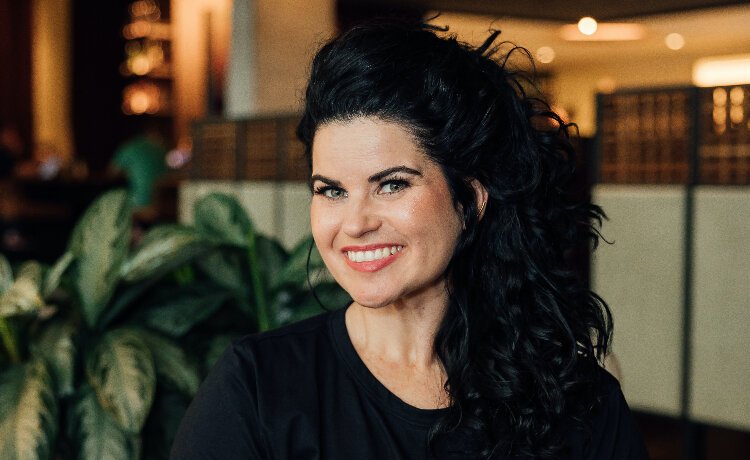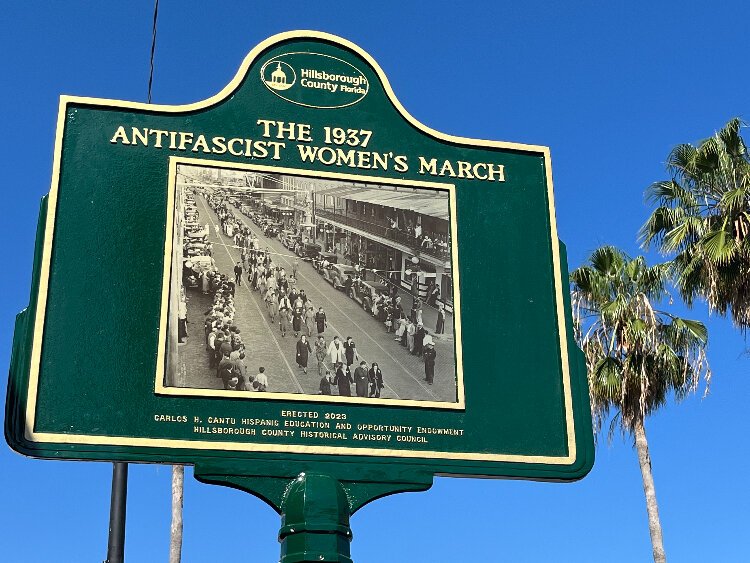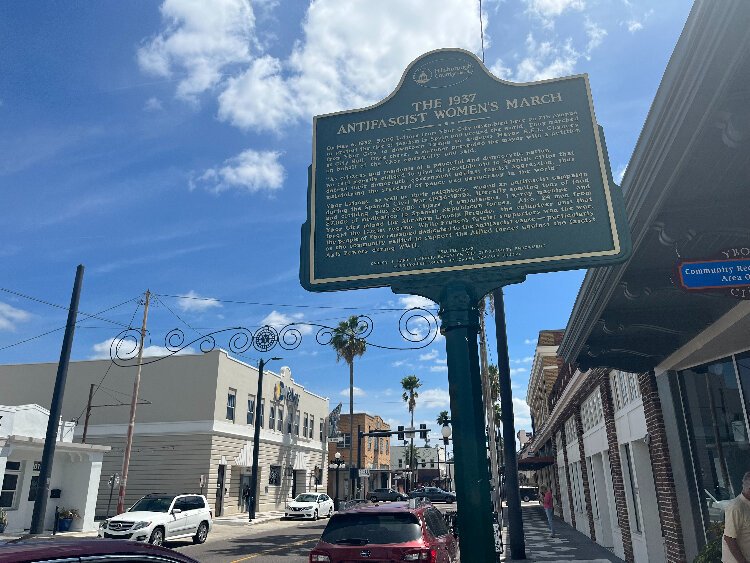Tampa native Sarah McNamara explores Ybor City, family history in her new book
Tampa native and historian Sarah McNamara, whose family came to Ybor City from Cuba at the turn of the 20th century, tells the story of Ybor's antifascist Latina political and labor leaders in her book "Ybor City: Crucible of the Latina South."
For Sarah McNamara, Ybor City history is family history.
She’s a Tampa native whose Ybor roots stretch back to the arrival of the first family member from Cuba in the early 1900s. McNamara’s also a historian, an assistant professor of history at Texas A&M, whose first book, “Ybor City: Crucible of the Latina South,” explores a little-known but significant part of Ybor City history that she first discovered from her grandmother.
The book and an accompanying historical marker and mural spotlight the 1937 antifascist women’s march from Ybor to Tampa City Hall and, more broadly, how immigrant and U.S.-born Latinas in Ybor with leftist, pro-labor political views fought for social and economic justice and against fascism in the era of Jim Crow laws, the Great Depression and, internationally, the Spanish Civil War.
Between the unveiling of the mural and historical marker at Tampa’s Ybor City Community Redevelopment Agency office on East Seventh Avenue, and the publication of the book, McNamara has been a frequent flier back home for special events. She gave a talk and led a tour during Tampa’s recent Archives Awareness Week. She’ll return in mid-September for a trio of events. A talk at Cafe con Tampa at Porticos in Tampa and an author discussion at Tombolo Books in St. Petersburg are both on September 15th. A Florida Conversations talk at the Tampa Bay History Center follows on September 20th.
Keeping history alive
“Ybor City: Crucible of the Latina South” focuses on the time period from the mid-1880s to the 1960s. It starts when Cuban immigrants, including McNamara’s great-great-grandmother Amelia Blanco Alvarez, arrive in a sparsely populated area of the Jim Crow South and stretches to the 1960s, when the cigar factories that were once a pillar of Ybor have faded into the background.

“My family has been in Ybor City since the turn of the century,” McNamara says. “My mom’s family is predominantly Cuban and people of Spanish descent who were cigar-makers and cigar workers who lived and worked in Ybor. So, Ybor City just seemed like water to me, something that always was. I went to the Cuban jeweler on Seventh Avenue to get earrings. We went to the Columbia Restaurant for all important family events. So I grew up in Tampa and I grew up surrounded by the history of Ybor City. In the book, I say it’s something that my grandmother always kept alive. In the introduction, I say something to the effect that she was on a one-woman mission to be sure that my sister and I never forgot what it was like to be of and from Ybor City.”
Her grandmother, Norma Alfonso Blanco, was a docent at the Ybor City Museum in its early years and McNamara gave tours while in high school.
“In the book, I write about how there was the official tour and then there was this tour that the women who lived in Ybor City had put together on their own that was very different than what the museum had put together,” McNamara says. “I grew up with these stories of the activism that was critical to Ybor City. I grew up with stories of what it was like to work in the Cuban cigar factories, what the poverty was like, what it was like to work so hard to make so little.”
When McNamara was a small child, her grandmother clipped out a black and white photograph that accompanied a newspaper article recalling the 1937 antifascist march. She then drew arrows to family members in the photograph, McNamara’s great-great-grandmother, Amelia Blanco Alvarez, and great-aunt, Margot Falcón Blanco. Decades later, that lasting memory helped inspire the book.
Same state, very different immigrant experience
“Ybor City: Crucible of the Latina South” started as McNamara’s doctoral dissertation at the University of North Carolina-Chapel Hill before going through numerous revisions and rewrites. She says she uses Ybor City as a microcosm to look at how people, places and politics change over time and become what they are. One significant point is that the Cuban immigrant experience in Ybor City, living with Jim Crow laws, Ku Klux Klan activity and the Great Depression is unique, even within the state.
“It’s a very different experience than what we see in places like Miami, where, after 1959 for the first generation of those who are emigrated post-Castro, people are celebrated by the United States Government as those who rejected communism,” she says. “The two groups, while sharing national background, have distinctly different experiences within the same state decades apart. And it shapes the cities and their politics in different ways down to today. In the telling of the book, that’s what I’m looking at. And I’m really looking at the work of women and women’s politics, Latina politics, as being central to this story.”
Often, they arrive in Ybor with radical leftist politics. They are active in the Cuban independence movement and remain part of it in Tampa. They fight for fair and equal rights and fair wages, things that did not exist in their home country.

“When I look at the history of Ybor City, women are not political actors, they are political partners,” McNamara says. “Women are in factories and they are working. Women are attending political meetings. But women become extremely important to this process in the 1930s. In the 1930s there is a collision of many things happening in the city of Tampa and the cigar industry. You have the height of the Great Depression and, in Ybor City, the way the industry responds is by laying off male cigar workers en masse and hiring women. Because they could hire women for less money to do the same work. So what happens in Ybor City is you have a large unemployed Latino population and a Latina population that is employed. This causes a whole host of shifts. Women become the primary members in labor unions. They become the primary breadwinners. They are making more money. And men are having a really difficult time not only getting work, they’re having a hard time getting access to the relief that the WPA, the Works Progress Administration, provided in Tampa. The reason they’re having a hard time with that is because those who lead the WPA boards only have so many spots and they tend to be headed by Anglo officials who are more likely to give support to people who are like themselves. Those who are from Ybor are very upset.”
Women become advocates for themselves and their community. The 1937 march is a response to the aerial bombing of Guernica in the Spanish Civil War, an attack on civilians to support fascist Franciso Franco in his fight to overthrow the legitimately-elected Republican government. Thousands take part. McNamara says varying estimates have a crowd of 5,000 or 7,000. The march was in opposition to Franco and other fascist regimes around the globe, but also to protest the prejudice, discrimination and unfair labor tactics toward Latinos in Tampa.
Historical marker and mural
McNamara initially contacted the City of Tampa three years about ago to share her idea for a historical marker and mural commemorating the 1937 antifascist march. Once she finished the book, she returned to the project. She submitted an application to the Hillsborough County Historical Advisory Council to put up a marker that would be based on information gathered by her and other researchers, particularly Anna Varela-Lago, who compiled an oral history of the Spanish Civil War.
Working with Tampa’s Division of Arts & Cultural Affairs on the mural, McNamara wanted a Cuban American artist who lived in Ybor to design and paint the project. She got one in Michelle Sawyer. Sawyer researched historic photographs, the application for the historical marker and McNamara’s then-unpublished book to guide her design for the mural.

Unveiled in late March on the wall of the Ybor City Community Redevelopment Area office on East Seventh Avenue, the mural features three women. Spanish Communist Party and anti-fascist leader Dolores Ibárruri was an international figure known for her impassioned fight to defend the Spanish Republic against Franco. Ibárruri was known as the “Passion Flower” and Sawyer also painted passion flowers on the mural to represent her. (The white triangles on the mural are another symbol, representing the Ku Klux Klan activity and intimidation in Tampa during the 1930s.)
Guatemalan labor organizer Luisa Moreno was a feminist, antifascist, civil rights advocate and labor organizer. Between 1935 and 1937, she worked in Ybor City as a labor organizer for the Cigar Maker’s International Union and became active in the antifascist movement, helping to organize and lead the 1937 march. She went on to become an influential national leader in the labor movement.
The third woman is McNamara’s great-aunt, Margot Falcón Blanco. McNamara said she was shocked and moved when she saw that Sawyer had “Aunt Margot” on the draft design for the mural.
“To me, her inclusion represents the everyday political lives of Latinas in Ybor as well as the memories and histories that live in Tampa,” she says.
The redevelopment and population boom transforming Tampa and Ybor City make the historical marker and mural all the more vital, McNamara says.
“Now as Ybor City is changing and going through this renewed moment of development, remembering what was there and what made it is really important,” she says.
McNamara has also started work on her next project, a book on the history of the state of Florida that delves into why its politics swing.
For more information on Sarah McNamara’s upcoming author events in Tampa Bay, join her mailing list.
To read more, go to Book Excerpt: “Ybor City: Crucible of the Latina South” by Sara McNamara














